29+ Latest Live Streaming Statistics For 2024
What is the state of live streaming?
Live streaming is here to stay. And if you want to be a part of it, you’ll need to be aware of the latest live streaming statistics to get an idea of where the industry is headed.
In this post, you’ll find all of the live streaming statistics you need to know. This will paint you a picture of just how big the online video streaming market has become over the years.
You’ll also be able to pick up a few strategies that could help you enter this exciting world.
Editor’s picks
- Twitter gets more unique visitors during live events. (Twitter Marketing)
- Live streaming had a 99% year-over-year growth of hours watched in 2020. (Forbes1)
- Gaming and esports drive live streaming. (Restream)
Live streaming usage statistics
How have people embraced live streaming? In this section, you’ll learn just how popular it’s become especially during the Covid-19 pandemic. You might also pick up a few things about its importance for businesses.
There’s been an uptick in live streaming since the pandemic hit.
The pandemic caused people to stay at home. This development led to more people live streaming than ever before. Of all the live streaming platforms, Facebook had the most views as it grew by 239%% from March to May 2020.
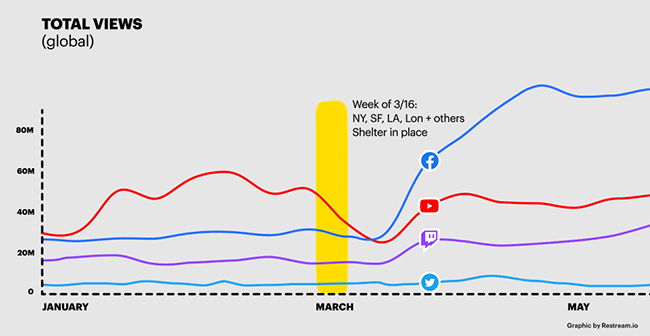
Twitch had the most hours watched with an increase of 267% within the same period. YouTube came in at third place for both most views (14% increase) and most hours watched (111% increase).
Source: Restream
Students resorted to live streaming as a response to the pandemic.
A study in 2020 found that more than half of US elementary and high school students would have had to attend classes virtually in the fall because of the pandemic.
At the time, 52% said that they would attend school virtually while 25% would attend every day. Around 19% decided that they would combine in-person learning with online methods.
Source: CNBC1
Twitter gets more unique visitors during live events.
Twitter gets up to 14% more unique visitors when there’s a live event. This is according to the social media platform itself. It also adds that video views for US brand and media publishers went up by as high as 67% from Q1 2019 to Q4 2020.
Source: Twitter Marketing
80% of users would rather watch a live video than read a blog.
People are more inclined to watch a live video than read a brand’s blog. What’s even more shocking is that 82% of surveyed users said that they prefer live video over a company’s social posts.
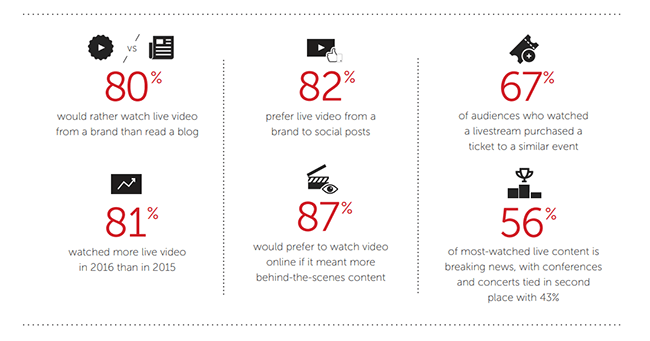
It’s also worth noting that 67% of people who watched a live stream eventually purchased a ticket for a similar event.
Source: New York Magazine (via Vimeo Livestream)
32% of YouTube users watched a live stream on the platform.
A Q3 2020 Global Web Index report said that 32% of YouTube users have watched a live stream video within the month. But while that is huge, a significant number of users are on the platform to view other types of video content.
For instance, 58% watched a music video within the same time period. 38% viewed a TV show or clip.
Source: Global Web Index (via eMarketer)
Live streaming had a 99% year-over-year growth of hours watched in 2020.
Yes, live streaming had a 99% year-over-year growth in hours watched between March and April 2020. The medium also clocked a 45% growth within the same period.
The huge growth of live streaming combined with the expanding live streaming capabilities will allow marketers to capitalize on monetization opportunities.
And live streaming isn’t just big on social media sites. Even online fitness platforms like iFit and Peloton offer classes through live streaming. Spotify is also streaming virtual concerts.
Source: Forbes1
More people use live streaming at funerals amid the pandemic.
Because of the pandemic, more people resorted to live streaming so they can still attend memorials.
Covid-19 protocols prevented people from being physically present in memorial services. But thanks to livestreaming, those who can’t be there—including those that were stranded in other countries—were able to join in.
Source: The Patriot Ledger
Live streaming demographics statistics
You might walk away surprised about how live streaming is being used as well as who is using it. While your mind immediately goes to gaming, you have to understand its importance in the entertainment sector.
Kids aren’t the only ones benefiting from the live video streaming market.
Younger people stream for gaming; older people stream for entertainment.
Those aged 24 and under will most likely stream for gaming — around 78% of them according to a study by Restream. By contrast, most of those that are 45 years old and above will use video streaming for entertainment purposes.

There’s also a significant number of people who use it for professional reasons.
Source: Restream
24% of users aged 16 to 64 watched live streams during the pandemic
When asked what form of media US internet users consumed during the pandemic (March 2020), respondents placed live streams in 7th place at 24%.
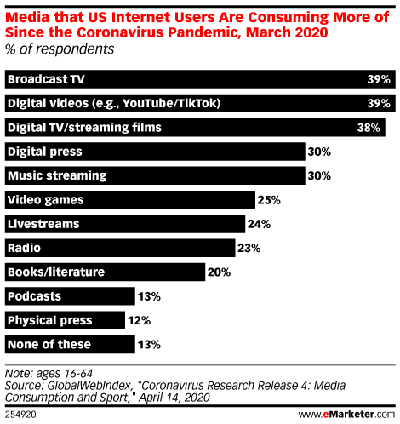
Broadcast TV and digital videos lead the pack at 39% each. It’s followed closely by digital TV (38%) then digital press (30%), music streaming (30%), and video games (25%). Other media formats in the list include radio, books, and podcasts.
Source: eMarketer
Live streaming business statistics
The link between live streaming and ecommerce is getting stronger every year. Businesses have more reasons today to invest in live streaming to promote their products and services.
Don’t believe us? Then check out these live streaming statistics for yourself.
Videos help users understand a product or service.
According to 94% of video marketers, videos help customers increase their understanding of a product or service. 86% said that video content increased traffic to their websites. 78% are of the opinion that videos directly helped increase sales.
Source: Wyzowl
Live ecommerce is shaping China’s economy.
Live streaming plays a crucial role in boosting China’s ecommerce. In a 2020 survey, two-thirds of Chinese consumers reported buying products after watching live streams in the past year.
The reason why it’s so effective is because live streams combine instant purchasing of a featured product and the fun of audience participation. Viewers are able to interact with an online seller through a chat feature or by pressing reaction buttons.
During Alibaba’s Singles’ Day 2020, the first 30 minutes of the event generated $7.5 billion in total transaction value.
Source: McKinsey
The Olympics was bad for traditional TV but great for live streaming.
NBC’s telecasts of the 2021 Olympics did not perform so well. The first night of the Tokyo Olympics was down by as much as 32% compared to the first night in the Rio Summer Games in 2016.
However, streaming platforms that showed the Olympics hit a record with 746,000 viewers. The downward trend of traditional platforms is understandable as online streaming gives viewers more options and competition for viewers’ attention.
Source: Los Angeles Times
YouTube and Facebook beat Twitch in one category.
YouTube and Facebook, who are both offering live streaming, are ahead of Twitch in one category. That category is hours watched per hour streamed.
Even though Twitch has 10 and 50 times more unique channels than YouTube Gaming and Facebook respectively, the gap in horse isn’t that far off from each other.
Source: Forbes2
Bloomingdale’s hosted 50+ live stream events during the pandemic.
Bloomingdale’s hosted more than 50 shoppable live stream events during the pandemic. It found that this medium is the best way to reach customers while they’re at home.
The timing couldn’t be better for the brand. It noted that people today are willing to spend on pricey clothes, shoes, and apparel as they get ready to leave their houses again.
Source: CNBC2
Related Reading: How COVID Has Impacted Small Business: 25 Important Statistics.
Social media sites are adding in-app shopping to live streaming.
Inspired by China’s ecommerce live streaming success, social media platforms are now developing shopping capabilities in their respective live streaming features.
For instance, Facebook developed a native live stream shopping tool and now positions itself as “the new QVC”. Walmart also collaborated with TikTok to offer its products through live streaming.
Even Amazon is joining in with the launch of Amazon Live, a platform that offers several shoppable shows that also enables brands to create their own programming.
Source: Fortune
Related Reading: 40+ Latest Social Media Statistics You Need To Know.
Instagram launched Live Room for live streaming broadcasts.
Instagram has finally released a feature that its users have long requested for. It’s called Live Room and it’s designed to allow up to four people to broadcast live together simultaneously.
Before the Live Room feature was a thing, people were only able to invite one guest. This limited the type of content a user could broadcast.
It also has another benefit — it makes it easier for creators to make money. Live Room lets users interact with a creator through badges as well as features like shopping tools and a live fundraiser functionality.
Source: TechCrunch
Related Reading: 30+ Top Instagram Marketing Statistics And Trends.
Video game live streaming statistics
Gaming wouldn’t be as big as it is today without the help of live streaming technology. And believe us — this industry is showing no signs of slowing down.
Here are some interesting facts and statistics about live streaming for video games.
Gaming and esports drive live streaming.
54% of live streaming content are from the gaming and esports category. About 17% are from the entertainment industry. Professional content makes up about 9%. And everyday life (like vlogging) is 6%.
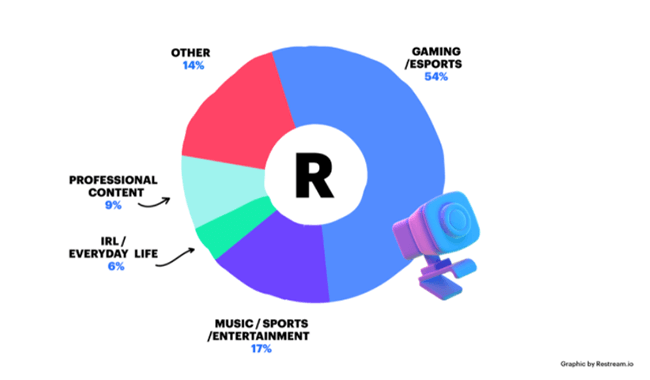
The remainder is composed of different topics.
Source: Restream
Twitch has 30 million average daily visitors.
Twitch, one of the biggest platforms for live streaming, gets an average of 30 million daily users. And there are more than 7 million unique users that go live on Twitch every month.
The company claims that their users watched 1 trillion minutes of content in 2020.
Source: Twitch
In 2019, League of Legends was the most popular video game.
The most popular game to live stream on Twitch in 2019 was League of Legends. The game has enjoyed some success in the years prior. But in 2018, Fortnite stepped up and took the top spot.
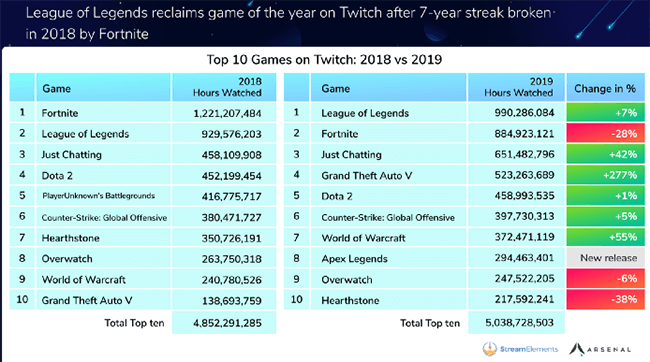
Other popular games at the time included Dota 2, Grand Theft Auto V, Counter-Strike: Global Offensive, World of Warcraft, Apex Legends, Overwatch, and Hearthstone.
Source: Stream Elements
Gaming is expected to continue growing even after the pandemic is over.
The rollout of Covid-19 vaccines means we’re inching closer to normalcy. And yet, the video game industry—along with gaming video content—is predicted to continue growing.
The consumption of gaming content (which includes live streaming) grew in 2021. In 2020, 71% of millennial gamers said they watch gaming content. But by the following year, the percentage rose by 18%, meaning 1.2 billion people watched other people play games. This generated $9 billion in revenue.
Twitch helped improve user engagement by introducing people to games like Fall Guys and Among Us.
Source: Nielsen
Global esports revenues will grow to $1.084 billion in 2021.
According to Newzoo, global esports revenues will grow to $1.084 billion in 2021. That’s a year-on-year growth of 14.5%. For comparison, the 2020 esports revenue was $947.1 million.
The same report says that the global games live streaming audience will hit 728.8 million in 2021. This is 10% higher than it was in 2020.
Source: Newzoo
YouTube Gaming has its best year in 2020.
The Verge reports that gaming content on YouTube doubled in viewership since 2018. YouTube Gaming’s head, Ryan Wyatt, stated that their users watched 100 billion hours of gaming content on the platform.
This is twice the number they had in 2018.
And of the 100 billion hours consumed, 10 billion of those are from live streamed events. In addition, YouTube says it now has over 40 million active gaming channels with 80,000 channels going past the 100,000 subscriber mark in the past year.
Source: The Verge
Live streaming growth statistics
How big will live streaming get? Here are some predictions from credible sources we found online. This should give you a better idea of what the live streaming industry will look like in a couple of years.
Live video streaming will continue to grow in the next few years.
According to Grand View Research, the live streaming industry will continue to grow in the next couple of years. By 2028, it’s expected to become a $223.98 billion industry.
This optimism comes from the rise of other technological advancements such as block-chain technology in video streaming as well as the use of artificial intelligence to improve video quality.
There’s also the growing adoption of cloud-based video streaming solutions that increase the reach of video content.
Source: Grand View Research
Live streaming will be worth 70.05 billion by 2021.
The live streaming market is expected to take a huge leap from $30.29 billion in 2016 to $70.65 billion in 2021 according to Research and Market.
One reason for the market increase is the adoption of pay TV and OTT solutions for streaming video content. Streaming has many advantages such as the ability to skip ads and on-demand viewing. Users are also able to watch events at their own pace.
Source: Research and Markets (via PR Newswire)
309 million Chinese users watched ecommerce live streams.
309 million Chinese users—which is a third of internet users in the country—watched live streamed sales events in June 2020. This is an increase of 16.7% from March of the same year.
The reason for the spike is the pandemic. It closed down businesses which affected offline sales in the country. However, this opened up the doors for entrepreneurs to approach customers through live streaming.
Clearly, there is a lot more room for growth in the ecommerce space. Choosing an ecommerce platform and launching an online store is no longer the only option.
Source: KrAsia
Related Reading: 22 Top Ecommerce Statistics And Trends You Should Know.
Chinese live commerce sales are expected to reach $423 billion by 2022.
Live streaming ecommerce in China only took less than five years to develop into an innovative sales channel. It has an estimated penetration of 10%. Its compound growth rate grew more than 280% between 2017 and 2020 where it reached $171 billion.
That’s why Chinese sales are expected to reach $423 billion come 2022.
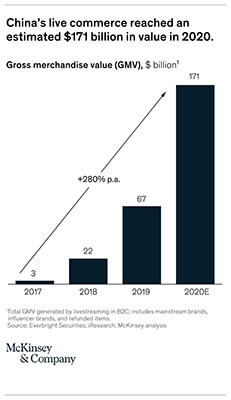
Source: McKinsey
Live streaming for ecommerce is also big in Singapore.
By the end of 2020, conversations around live streaming and the gamification of the online shopping experience increased. By how much? It grew by 1,890% since March of the same year.
There’s also been talk about online shopping in Singapore. It’s increased by 235% year-on-year in 2020. The most popular product category? That would be home furniture and essentials.
During that period, fitness and yoga equipment experienced a demand. Online shopping site Shopee reported a 200x jump in fitness equipment sales as well as a 75x increase in yoga equipment.
Source: WARC
The live streaming market is expected to grow to $25 billion by 2023.
In 2020, the live streaming market was worth about $6 billion in the US. By the end of 2021, it’s expected to reach $11 billion — this according to Coresight Research.
The research group believes that by 2023, the live streaming market will reach $25 billion.
That’s still far from China’s numbers though where live streaming hit $125 billion in sales in 2020.
Source: CNBC2
Live streaming statistics sources
Final thoughts
The future’s looking bright for live streaming. And with different social media platforms trying to emulate the success of ecommerce live streaming in China and other countries, you can bet that technology will continue pushing forward to make live streaming the place to be when it comes to generating sales for companies.
Make sure your business isn’t left out. Think about investing in live streaming today.
Related Reading:
